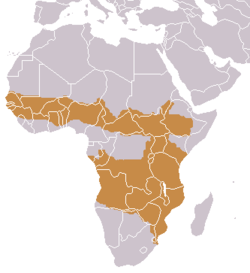Taxonomy and evolution
The Swedish zoologist Carl Jakob Sundevall named the species Canis adustus in 1847. [12] The German zoologist Max Hilzheimer proposed a different genus as Schaeffia adusta in 1906. [7]
Fossil remains of the side-striped jackal date to the Pliocene era. [13] A mitochondrial DNA sequence alignment for the wolf-like canids gave a phylogenetic tree with the side-striped jackal and the black-backed jackal being the most basal members of this clade, which means that this tree is indicating an African origin for the clade. [14] [15]
In 2019, a workshop hosted by the IUCN/SSC Canid Specialist Group recommends that because DNA evidence shows the side-striped jackal (Canis adustus) and black-backed jackal (Canis mesomelas) to form a monophyletic lineage that sits outside of the Canis/Cuon/Lycaon clade, that they should be placed in a distinct genus, Lupulella Hilzheimer, 1906 with the names Lupulella adusta and Lupulella mesomelas. [3]
Studies indicate that the dentition of the side-striped jackal is different to that of the black-backed jackal, and propose that the side-striped jackal should be classified as Schaeffia adusta following Hilzheimer in 1906. [8] [9] [10] It is the surviving member from an African group of which the early Pliocene African Eucyon khoikhoi sp. nov. is the basal member. [9] [10] The recent discovery of the 5 million years old E. khoikhoi supports the proposed radiation of the genus Eucyon , with the oldest E. ferox in North America, to E. davisi in North America then to China, to E. debonisi in Western Europe, to E. khoikhoi in Africa. [9]
Description
The side-striped jackal is a slender, medium-sized canid, which tends to be slightly larger on average than the black-backed jackal. Body mass ranges from 6.5 to 14 kg (14 to 31 lb), head-and-body length from 69 to 81 cm (27 to 32 in) and tail length from 30 to 41 cm (12 to 16 in). [16] Shoulder height can range from 35 to 50 cm (14 to 20 in). [17] Its pelt is coloured buff-grey. The back is darker grey than the underside, and the tail is black with a grey, almost silver tip. Indistinct white stripes are present on the flanks, running from elbow to hip. The boldness of the markings varies between individuals, with those of adults being better defined than those of juveniles. [11]
The side-striped jackal's skull is similar to that of the black-backed jackal's, but is flatter, with a longer and narrower rostrum. Its sagittal crest and zygomatic arches are also lighter in build. Due to its longer rostrum, its third upper premolar lies almost in line with the others, rather than at an angle. Its dentition is well suited to an omnivorous diet. The long, curved canines have a sharp ridge on the posterior surface, and the outer incisors are canine-like. Its carnassials are smaller than those of the more carnivorous black-backed jackal. Females have four inguinal teats. [11]
Dietary habits
The side-striped jackal tends to be less carnivorous than other jackal species, and is a highly adaptable omnivore whose dietary preferences change in accordance to seasonal and local variation. [18] It tends to forage solitarily, though family groups of up to 12 jackals have been observed to feed together in western Zimbabwe. In the wild, it feeds largely on invertebrates during the wet season and small mammals, such as the springhare, in the dry months. It frequently scavenges from campsites and the kills of larger predators. In the wild, fruit is taken exclusively in season, while in ruralised areas, it can account for 30% of their dietary intake. The side-striped jackal tends to be comparatively less predatory when compared to other jackal species. It typically does not target prey exceeding the size of neonatal antelopes, and one specimen was recorded to have entered a duck's pen to eat their feed, whilst ignoring the birds. [11]
A side-striped jackal from Angola was found to be a host of an intestinal acanthocephalan worm, Pachysentis angolensis . [19]
This page is based on this
Wikipedia article Text is available under the
CC BY-SA 4.0 license; additional terms may apply.
Images, videos and audio are available under their respective licenses.




